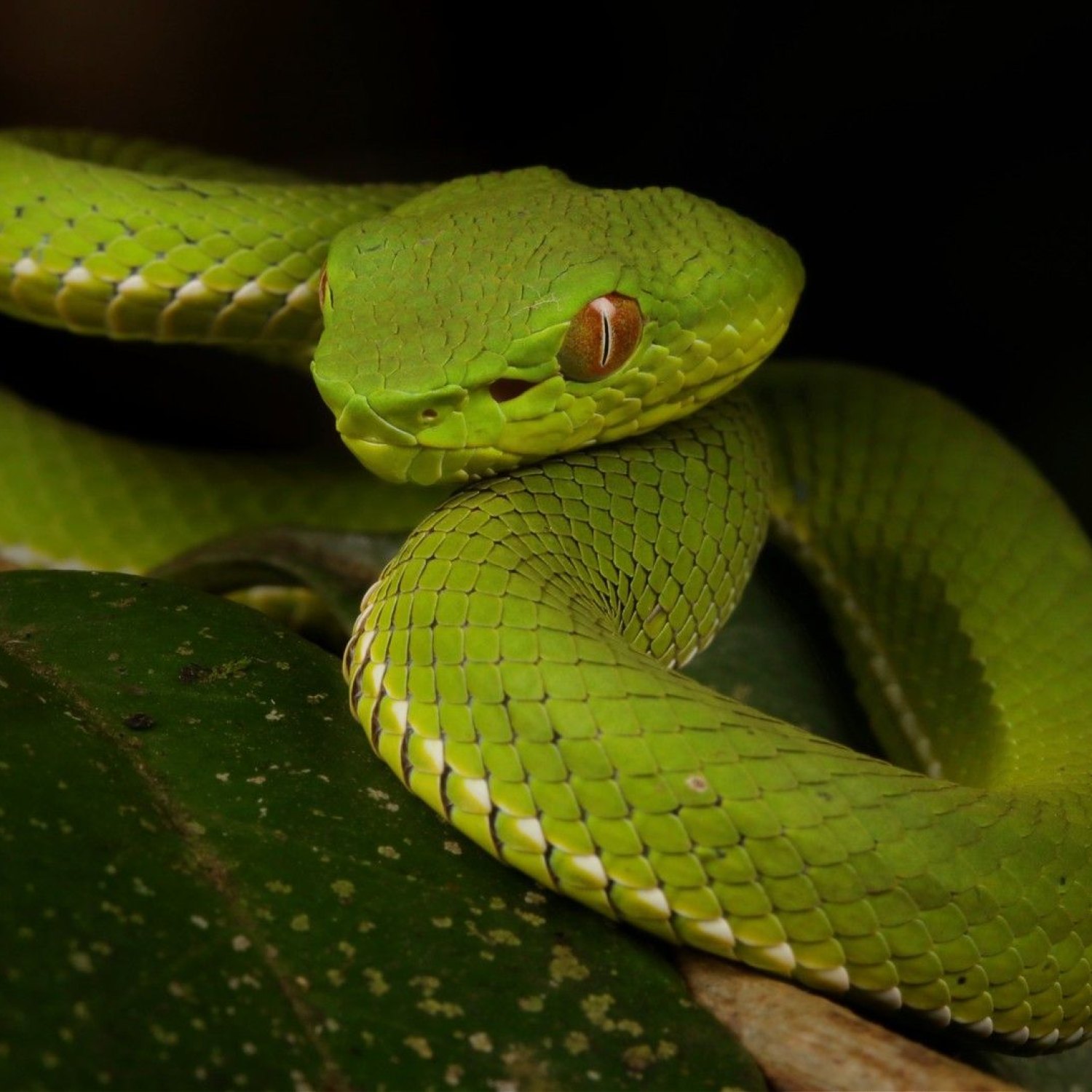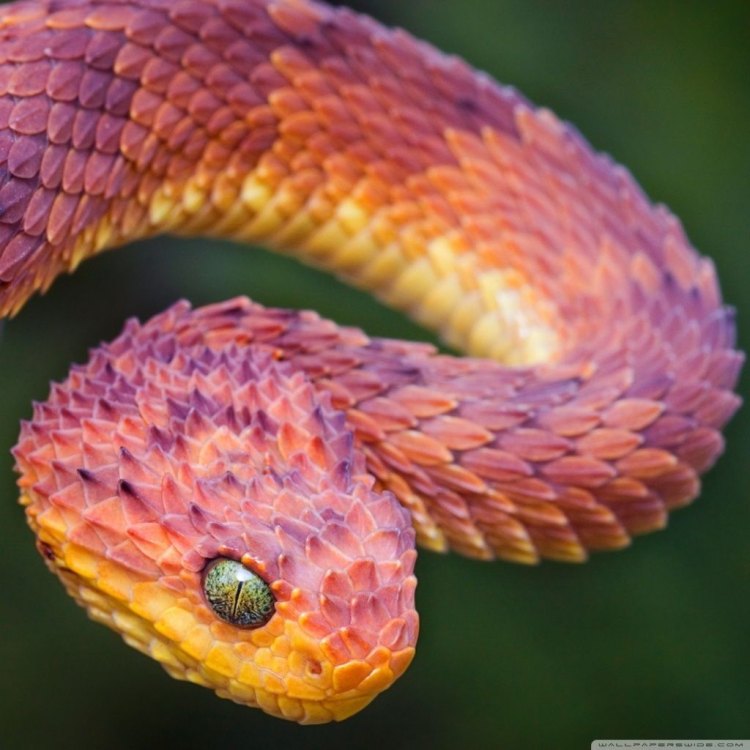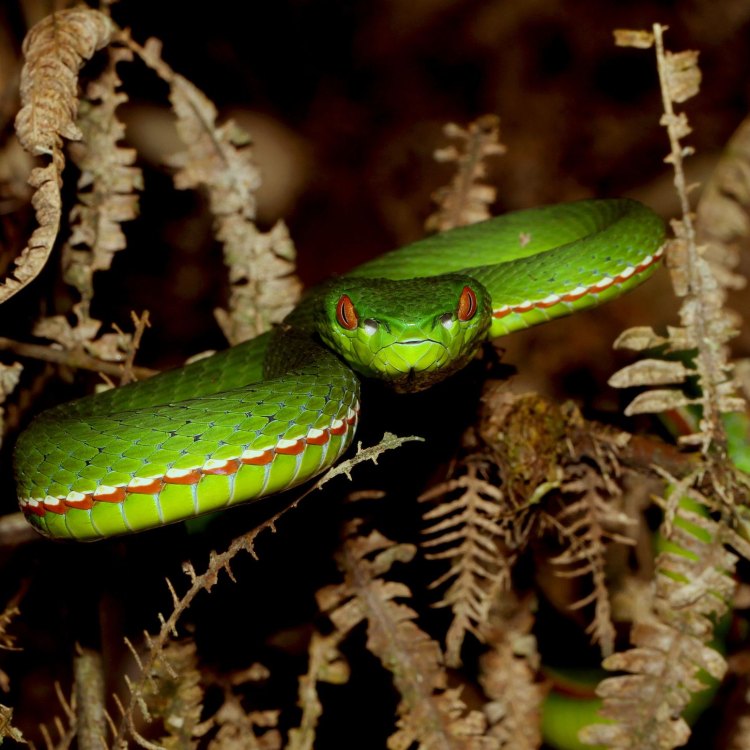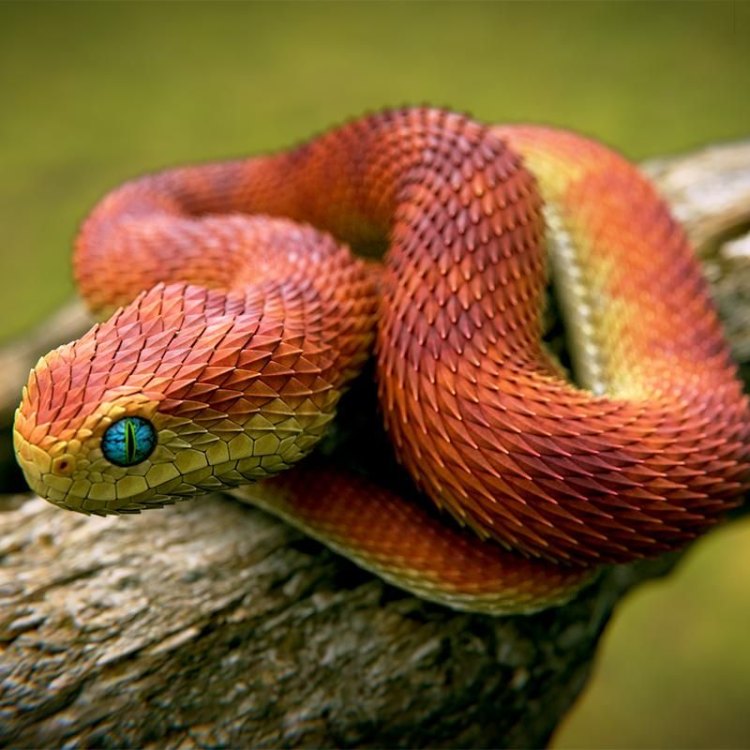
Tree Viper
Average length ranges from 60 to 90 cm (24 to 35 inches)
The Tree Viper, part of the Viperidae family, is a slender and elongated snake with a distinctive triangular-shaped head. It is an arboreal species found in trees, with an average length ranging from 60 to 90 cm (24 to 35 inches). This venomous snake uses camouflage to blend in with tree branches, making it hard to spot. Beware of this stealthy creature while hiking in the wild! #TreeViper #Viperidae #Arboreal #Wildlife
Animal Details Summary:
Common Name: Tree Viper
Kingdom: Animalia
Habitat: Tropical rainforests, lowland forests, and montane forests
The Enigmatic Tree Viper: A Venomous Beauty of the Rainforest
The lush green canopies of the tropical rainforests are home to some of the most captivating and mysterious creatures. Among them, hidden in the branches and leaves of trees, is a stunning creature that strikes fear and awe in the hearts of many – the tree viper.Scientifically known as Trimeresurus, the tree viper is a venomous snake from the family Viperidae and can be found in Southeast Asia and South Asia. With its bright coloration, slender body, and venomous bite, the tree viper has earned a reputation as a deadly predator Tree Viper. But there is more to this beautiful creature than meets the eye.
In this article, we will take a closer look at the tree viper and unravel its captivating secrets, from its appearance, behavior, to its role in the ecosystem.
The Tree Viper's Appearance
Standing out in the greenery of the rainforest, the tree viper is a sight to behold. Its body can reach an average length of 60 to 90 cm (24 to 35 inches), with some species growing even longer. However, the length can vary depending on the species, with some reaching up to 2 meters (6.6 feet).The tree viper has a slender and elongated body, allowing it to move swiftly and effortlessly among branches and tree trunks. Its head is triangular-shaped, with distinct patterns and markings on its scales, giving it an almost mythical appearance.
One of the most striking features of the tree viper is its vibrant coloration Tornjak. They can come in shades of bright green, yellow, brown, or gray, often with intricate patterns and markings that help them blend in with the surrounding foliage. This camouflage allows them to remain hidden from predators and easily ambush their prey.
Habitat and Distribution
As their name suggests, the tree viper is an arboreal species, meaning they spend most of their time in trees. They are predominantly found in tropical rainforests, lowland forests, and montane forests, which are abundant in Southeast Asia and South Asia.The tree viper has adapted well to the life in the trees, with specialized features that make them perfect for this habitat. They have a prehensile tail, which is used to grip branches and aid in their movement. Their triangular head also helps them maneuver easily between branches and foliage.
Tree vipers have a wide geographical distribution, with species found in countries such as India, Bangladesh, Myanmar, Thailand, Indonesia, and Malaysia. Each country has its unique tree viper species, adding to the biodiversity of these regions.
Feeding and Hunting
The tree viper is a carnivorous species, meaning they prey on other animals for their survival. They are skilled hunters and have a varied diet, which usually includes birds, lizards, and rodents.Their venom plays a crucial role in how they hunt. Unlike other venomous snakes that strike and release their prey, the tree viper's venom is hemotoxic, which means it attacks the victim's blood cells and tissue. This allows the snake to hold onto its prey until it is fully immobilized, making it easier to consume.
Tree vipers possess two small fangs at the front of their mouth, which they use to inject their venom into their prey. These fangs are located towards the rear of their upper jaw, giving them an almost perfect aim when striking at their prey.
The Venomous Bite of the Tree Viper
The tree viper is highly venomous, with some species having a potency that can kill a human within hours. However, these snakes are not aggressive and will only bite when they feel threatened or provoked.If a person does get bitten by a tree viper, they must seek immediate medical attention as their venom can cause severe tissue damage and lead to death if left untreated. However, with the availability of anti-venom, fatalities from tree viper bites have decreased significantly.
Importance in the Ecosystem
The tree viper may have gained a reputation as a deadly predator, but its role in the ecosystem is crucial. As ambush predators, they help control the population of small animals, such as rodents and birds, which can have a significant impact on the balance of the food chain.Moreover, tree vipers are also prey for other animals, such as birds, mammals, and larger snakes, making them an essential part of the food web in the rainforest.
Conservation Status
Like most other snake species, the tree viper faces threats such as habitat destruction, poaching, and illegal trade. Due to their stunning coloration, they are often captured and sold in the exotic pet trade, leading to a decline in their population.Several species of tree viper are also facing habitat loss due to deforestation and human encroachment. As a result, they are listed as vulnerable or endangered on the IUCN Red List of Threatened Species.
To ensure the survival of these beautiful creatures, various conservation efforts, such as habitat restoration and anti-poaching initiatives, are being carried out in their native habitats.
In Conclusion
The tree viper is a mesmerizing creature that embodies the beauty and danger of the rainforest. From its vibrant coloration, specialized adaptations, to its role in the ecosystem, there are numerous reasons to appreciate and protect this species.While it is essential to be cautious around tree vipers in their natural habitat, we must also recognize the vital role they play in maintaining the delicate balance of the rainforest. By educating ourselves and others about these magnificent animals, we can contribute to their conservation and ensure their survival for generations to come.
So, the next time you find yourself in the rainforest, remember to look up and marvel at the enigmatic tree viper – a venomous beauty of the rainforest.

Tree Viper
Animal Details Tree Viper - Scientific Name: Trimeresurus
- Category: Animals T
- Scientific Name: Trimeresurus
- Common Name: Tree Viper
- Kingdom: Animalia
- Phylum: Chordata
- Class: Reptilia
- Order: Squamata
- Family: Viperidae
- Habitat: Tropical rainforests, lowland forests, and montane forests
- Feeding Method: Carnivorous
- Geographical Distribution: Southeast Asia, South Asia
- Country of Origin: Various countries such as India, Bangladesh, Myanmar, Thailand, Indonesia, and Malaysia
- Location: Arboreal (found in trees)
- Animal Coloration: Bright green, yellow, brown, or gray, often with patterned markings
- Body Shape: Slender and elongated body, triangular-shaped head
- Length: Average length ranges from 60 to 90 cm (24 to 35 inches)

Tree Viper
- Adult Size: Adult size can reach up to 100 cm (39 inches)
- Average Lifespan: 15 to 20 years
- Reproduction: Sexual reproduction
- Reproductive Behavior: Viviparous (gives birth to live young)
- Sound or Call: Some species may produce a hissing sound as a defensive display
- Migration Pattern: Non-migratory
- Social Groups: Solitary
- Behavior: Arboreal and highly adapted for life in trees
- Threats: Habitat loss due to deforestation, illegal pet trade, hunting
- Conservation Status: Some species are listed as vulnerable or endangered
- Impact on Ecosystem: Important role in controlling populations of prey species
- Human Use: Some species are kept as exotic pets
- Distinctive Features: Long fangs, heat-sensing pits on the head, prehensile tail
- Interesting Facts: 1. Some species of tree vipers have a hemotoxic venom that can cause severe tissue damage. 2. They have specialized heat-sensing pits on their heads, known as loreal pits, which allow them to detect warm-blooded prey. 3. Tree vipers are excellent climbers and can move through the trees with agility. 4. Their coloration and pattern help them camouflage among the foliage. 5. Female tree vipers give birth to live young.
- Predator: Birds of prey, larger snakes, mammals

Trimeresurus
The Enigmatic Tree Viper: A Master of the Trees
Amidst the dense foliage of the rainforest, lies a spectacular creature that is often hidden from sight – the tree viper. With its sleek, arboreal lifestyle and a set of unique features, this snake has captured the curiosity of many. The tree viper, also known as the arboreal pit viper, is a fascinating species that reigns supreme in the canopy of tropical forests.The tree viper belongs to the subfamily Crotalinae, which includes other pit vipers such as rattlesnakes and copperheads PeaceOfAnimals.Com. However, this remarkable snake has evolved to thrive in a completely different habitat – the trees. While most venomous snakes are primarily ground-dwelling, the tree viper has adapted to a life high up in the trees.
One of the most distinctive features of the tree viper is its adult size, which can reach up to 100 cm (39 inches). This impressive size makes it one of the largest arboreal snakes in the world. However, their size can vary depending on the species and their geographical location. For instance, the golden tree viper found in Southeast Asia is smaller, measuring only 50 cm (19 inches) in length.
The tree viper's average lifespan is 15 to 20 years, making it a long-lived species compared to other snakes. This longevity can be attributed to their adaptability and highly specialized lifestyle in the trees, which offers protection from predators and access to abundant food sources.
Being an arboreal species, the tree viper's behavior and physical features are well-suited to a life among the trees Tarpon. They are solitary creatures, preferring to live and hunt alone. This behavior is primarily due to their non-migratory pattern – they tend to stay in the same area throughout their lives.
When it comes to reproduction, tree vipers engage in sexual reproduction. However, what sets them apart from most snakes is their reproductive behavior. They are viviparous – meaning they give birth to live young rather than laying eggs. This is an adaptation to their arboreal lifestyle since eggs are vulnerable to predators and cannot survive in trees due to the lack of suitable nesting sites.
While tree vipers are relatively silent creatures, some species may produce a hissing sound as a defensive display when threatened. However, they are not aggressive by nature and only use this behavior as a last resort. Their main defense mechanism is their venom, which acts as a powerful deterrent to potential predators.
Speaking of venom, the tree viper's venom is a cause for concern among humans due to its potency. Some species have a hemotoxic venom that can cause severe tissue damage, which can be deadly if left untreated. This venom also plays an essential role in their hunting strategy. The tree viper's long fangs inject venom into their prey, immobilizing and killing them before they can escape.
But what makes the tree viper an exceptional predator is its heat-sensing pits on its head, known as loreal pits. These pits allow them to detect warm-blooded prey, even in complete darkness. This gives them an edge when hunting, allowing them to strike with precision and accuracy.
Their impressive climbing abilities, aided by their prehensile tail, make tree vipers true masters of the trees. They can move with agility among the branches and vines, making them almost invisible to their prey. Their coloration and pattern also help them blend in with their surroundings, providing excellent camouflage against predators.
Apart from their role as top predators, tree vipers also play a crucial role in controlling populations of their prey species. This helps maintain a balance in the ecosystem, preventing any overpopulation that could disrupt the delicate ecosystem of the rainforest.
While tree vipers play an essential role in the rainforest, they face numerous threats that put their survival at risk. Habitat loss due to deforestation is one of the main concerns, with many populations of tree vipers declining due to the loss of suitable habitat. The illegal pet trade also poses a threat, with collectors eager to add these exotic snakes to their collections. Additionally, hunting for their skin and body parts for traditional medicine also contributes to their declining numbers.
As a result, some species of tree vipers are listed as vulnerable or endangered on the International Union for Conservation of Nature (IUCN) Red List. Conservation efforts are in place to protect these magnificent creatures and raise awareness about their importance in the ecosystem.
Despite their importance in the ecosystem, some humans have found a different use for tree vipers – keeping them as exotic pets. While some species are relatively easy to care for, they require specialized care and should only be kept by experienced and knowledgeable owners. Reptile enthusiasts who decide to keep tree vipers should ensure that they are acquiring the snake from a legal and ethical source to promote conservation efforts.
In conclusion, the tree viper is a remarkable and enigmatic creature that has adapted to thrive in a unique habitat – the treetops. With their impressive size, specialized features, and agile hunting abilities, they are truly masters of the trees. But with their habitat under threat and declining populations, it's crucial to raise awareness about the tree viper's importance in the ecosystem and take action to protect this majestic species.

The Enigmatic Tree Viper: A Venomous Beauty of the Rainforest
Disclaimer: The content provided is for informational purposes only. We cannot guarantee the accuracy of the information on this page 100%. All information provided here may change without prior notice.












